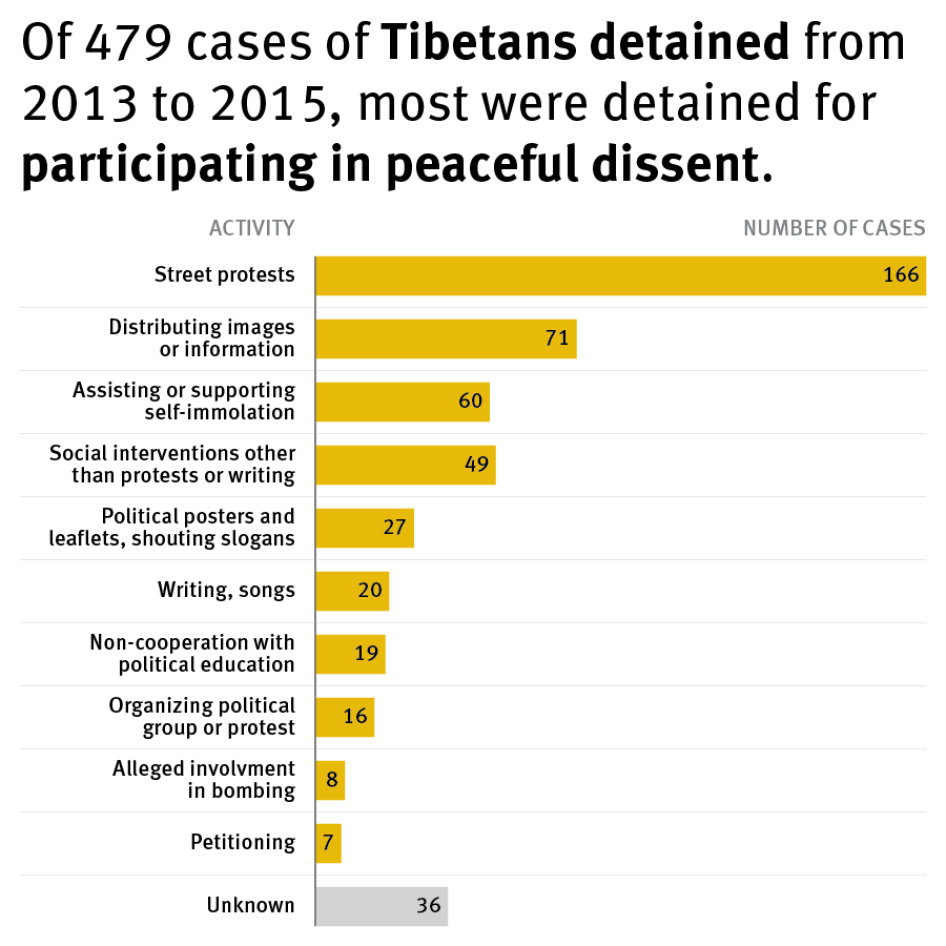(New York) – The Chinese government’s campaign to suppress peaceful dissent in Tibetan areas has continued to produce a high rate of detentions, prosecutions, and convictions since the outbreak of widespread unrest eight years ago, Human Rights Watch said in a new report released today. The authorities have detained people for types of expression and assembly that are protected under Chinese and international law and had been previously tolerated. Many of these cases took place in rural areas or involved segments of society not previously targeted.
“Tibetan areas are the forefront of the Chinese government’s country-wide crackdown on peaceful dissent,” said Sophie Richardson, China director. “The authorities are treating all Tibetans as potential dissidents and are trying to extend surveillance to the entire Tibetan community.”
The 86-page report, “Relentless: Detention and Prosecution of Tibetans under China’s ‘Stability Maintenance’ Campaign,” shows how changing patterns of unrest and politicized detentions, prosecutions, and convictions from 2013-2015 correlate with the latest phase of the government’s “stability maintenance” campaign – a policy that has resulted in unprecedented surveillance and control in Tibetan villages and towns.
The Tibet Autonomous Region remains nearly entirely closed to journalists, researchers, and individual tourists, and almost no official data is available. Human Rights Watch’s findings are based on a dataset of 479 cases drawn from reports by foreign media, the Chinese government, and exile sources. Human Rights Watch analyzed this data to identify changing patterns of detention and sentencing.
Previously unpublished documents reveal the devastating cost paid by a local community for a single protest, Human Rights Watch said. In April 2013, the trial and conviction of three lamas from Chamdo in the Tibet Autonomous Region for a minor charge of “harboring a criminal” led to police employing waves of collective punishment, intimidation, and repression throughout the wider community for over a year as they sought to find other suspects. The authorities detained, beat, and threatened scores of local Tibetans, and subjected others to political indoctrination and travel restrictions in an apparent attempt to obtain information about key suspects and deter further dissent.
Treatment in detention remains a serious concern, Human Rights Watch said. Fourteen of the detainees from Human Rights Watch’s dataset were reported to have died while in custody or shortly after release.
After 2012, thousands of officials who had been posted the previous year to villages across Tibet as part of the “stability maintenance” policy began to implement local-level measures to prevent dissent. In those communities, many social, cultural, and environmental activities that were previously considered harmless became a focus of state attention and punishment.
Many detainees and defendants from Human Rights Watch’s dataset, ranging in age from 14 to 77, were people who had merely exercised their rights to expression and assembly without advocating separatism. Others had simply criticized decisions by local officials in their villages, opposed a mining development, advocated for greater language rights, or shown sympathy for self-immolators. Dozens of protests ended with security forces opening fire on protesters, although there are no reports of violence by protesters at those events.
Human Rights Watch found that almost all reported expressions of dissent that led to detentions occurred in villages, small towns, or rural townships, rather than in cities as in the past – the same places where government “stability maintenance” measures have been implemented. The report identifies nine specific localities, or “cluster sites,” across the Tibetan plateau that, apparently in response to these measures, saw recurrent cycles of protest and suppression, increased politicized detentions, and longer sentences for relatively minor offenses compared to other areas.
Many of those detained and prosecuted during this period were local community leaders, environmental activists, and villagers involved in social and cultural activities. In the previous three decades, the authorities rarely accused such rural Tibetans of involvement in political unrest. Human Rights Watch identified seven protests, five of them with more than a hundred participants, in which villagers demanded the release of a detained community leader. The detention of local leaders and their communities’ mass support for them appears to be a new phenomenon.
An analysis of detention cases in this period indicated that, once detained, people with social influence, such as community leaders, religious professionals, writers, or singers were more likely to be sent for trial than others. Those detained for an action that had been singled out as a political priority for containment during this time, such as support of self-immolations, also faced a greater likelihood of being sent for trial.
“If the goal of the ‘stability maintenance’ campaign was to wipe out dissent among Tibetans, it has failed to do so,” Richardson said. “The basis of real stability is for China’s government to respect rights, understand and respond to local grievances, and roll back abuses by security forces across the plateau.”










